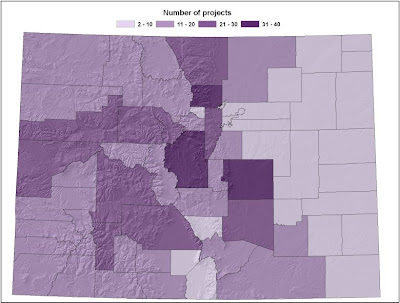
The 6th Annual Rare Plant Symposium, an off-shoot of the Colorado Rare Plant Technical Committee, took place on September 11, 2009. CNHP botanists Susan Panjabi and Jill Handwerk presented reviews of Colorado’s rare plant species, and solicited new information from participants. The meeting was attended by 50-60 people, including representatives of the Bureau of Land Management, City of Fort Collins, Colorado Natural Areas Program, Denver Botanic Gardens, The Nature Conservancy, US Fish and Wildlife Service, US Forest Service, University of Colorado Herbarium, and the Wyoming Natural Diversity Database, as well as other interested botanists from the region.
Some highlights included a report of new state records in New Mexico for two species: Porter’s feathergrass (
Ptilagrostis porteri), and Colorado Divide whitlowgrass (
Draba streptobrachia). Ben Legler was responsible for these finds, as well as discovering a new species of phlox from the Vermejo Park Ranch in northern New Mexico. These two species were previously believed to be endemic to Colorado. Although the new records extend the known range of the species, they are both still considered rare. Tim Hogan reported a county record and range extension for
Saussurea weberi in Custer County.
 Draba streptobrachia (Colorado Divide whitlowgrass)
Draba streptobrachia (Colorado Divide whitlowgrass)
Photo by Peggy Lyon
The meeting included quite a bit of discussion about the federally listed species, which have been receiving more monitoring attention recently. Many participants also noted the large number of occurrence records from the northwestern portion of Colorado (especially Moffat County) which have not been observed for 20 years or more. Although we have good records of these species from the late 1980’s, CNHP has so far been unable to secure funding to re-survey these occurrences, or to look for new ones in this area. One of our primary challenges is how to fund the continual updates needed to keep our database current, since “stale” data makes conservation planning and action more difficult.
 Ptilagrostis porteri (Porter’s feathergrass)
Ptilagrostis porteri (Porter’s feathergrass)

















